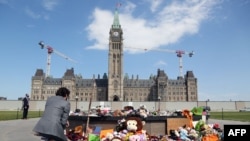Leaders of Indigenous groups in Canada say investigators have found more than 600 unmarked graves at the site of a former residential school for Indigenous children, which follows the discovery of 215 bodies at another school last month.
The new discovery was at the Marieval Indian Residential School, which operated from 1899-1997 where the Cowessess First Nation is now located, about 135 kilometers east of Regina, the capital of the province of Saskatchewan.
Ground-penetrating radar registered 751 ''hits," indicating at least 600 bodies were buried, said Chief Cadmus Delorme of the Cowessess. Some and perhaps most are from over a century ago. The gravesite is believed to hold the bodies of children and adults, and even people from outside the community who attended church there.
Perry Bellegarde, chief of the Assembly of First Nations, said it is not unusual to find such graves at former residential schools but is always a devastating discovery that reopens old wounds about the forced assimilation of native children at those often-abusive institutions.
Many non-Indigenous Canadians were not aware of the extent of the problems at the schools until the remains of 215 children were found last month at what was once the country's largest such school in British Columbia.
What are residential schools?
From the 19th century until the 1970s, more than 150,000 Indigenous children were forced to attend state-funded Christian boarding schools in an effort to assimilate them into Canadian society. Thousands of children died there of disease and other causes, with many never returned to their families.
Nearly three-quarters of the 130 residential schools were run by Roman Catholic missionary congregations, with others operated by the Presbyterian, Anglican and the United Church of Canada, which today is the largest Protestant denomination in the country.
The Canadian government has admitted its role in a century of isolating native children from their homes, families and cultures, and that physical and sexual abuse was rampant in the schools, where students were beaten for speaking their native language. That legacy of abuse and isolation has been cited by native leaders as a cause of alcoholism and drug addiction widely seen on reservations today.
Indigenous leaders have called it a form of cultural genocide.
Prime Minister Justin Trudeau on Friday called it "an incredibly harmful government policy that was Canada's reality for many, many decades and Canadians today are horrified and ashamed of how our country behaved."
He said the policy "forced assimilation" on the children.
What's behind the discovery of the remains?
A National Truth and Reconciliation Commission, which was set up as part of a government apology and settlement, issued a report in 2015 that identified about 3,200 confirmed deaths at schools. While some died of diseases like tuberculosis amid the often-deplorable conditions, it noted that a cause of death for about half of them often was not recorded.
The government wanted to keep costs down at the schools, so adequate regulations were never established, the reconciliation commission said.
It said the practice at the schools was to not send the bodies home to their communities. Delorme said the graves at the Saskatchewan school were marked at one time, but that the Catholic operators of the facility had removed them.
What apologies have been made?
Former Prime Minister Stephen Harper apologized in Parliament in 2008 for the government's role. Among the Christian denominations, the Presbyterian, Anglican and United churches also apologized for their roles in the abuse.
A papal apology was one of 94 recommendations from the reconciliation commission, but the Canadian Conference of Catholic Bishops said in 2018 that the pope could not personally apologize for the residential schools.
Former Pope Benedict XVI met with some former students and victims in 2009 and told them of his "personal anguish" over their suffering.
After last month's discovery, Pope Francis expressed his pain and pressed religious and political authorities to shed light on "this sad affair," but didn't offer an apology.
Trudeau said Friday he has spoken to Francis personally "to impress upon him how important it is not just that he makes an apology but that he makes an apology to indigenous Canadians on Canadian soil."
Archbishop Don Bolen of the Regina Archdiocese posted a letter on its website this week to the Cowessess First Nation in which he repeated an apology he said he made two years ago.
What compensation has been offered?
The reconciliation commission was created as part of a $5 billion Canadian ($4 billion U.S.) class action settlement in 2005, the largest in Canadian history.
Under the settlement, students who attended the schools were eligible to receive $10,000 Canadian ($8,143 U.S.) for the first school year and $3,000 Canadian ($2,443 U.S.) for every year thereafter. Victims of physical and sexual abuse were eligible for further compensation.
Trudeau has said the government will help preserve gravesites and search for unmarked burial grounds at other schools, but he and his ministers have stressed the need for indigenous communities to decide for themselves how they want to proceed.
The government previously announced $27 million Canadian ($22 million U.S.) for the effort in what it called a first step.








